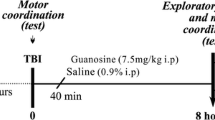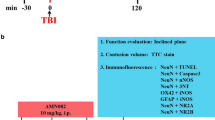ABSTRACT
Purpose
To investigate the possible impact of reduction of mitochondrial membrane permeabilization by modulation of the 18 kDa translocator protein mediated by Ro5-4864 over post-traumatic cerebral edema and metabolic crisis.
Methods
Cerebral microdialysis and intracranial pressure (ICP) monitoring were performed in Sprague–Dawley rats treated by intraperitoneal injection of either dimethylsulfoxide (vehicle) or Ro5-4864 following cortical contusion and further correlated with quantitative assessment of mitochondrial damage, water content in the injured tissue, modified neurological severity score, and lesion size.
Results
Ro5-4864 resulted in a profound decrease in ICP that correlated with improved cerebral metabolism characterized by significantly higher glucose and pyruvate and lower lactate concentrations in the pericontusional area in comparison with vehicle-treated animals. Reduced ICP correlated with reduced water content in the injured tissue; improved metabolism was associated with reduced mitochondrial damage evidenced by electron microscopy. Both effects were associated with a profound and significant reduction in glycerol release and lesion size, and correlated with improved neurological recovery.
Conclusions
The present study shows that Ro5-4864 has a favorable effect on the fate of injured brain, presumably mediated by improvement of metabolism. It further suggests that improvement of metabolism may contribute to ICP relief.







Similar content being viewed by others
REFERENCES
Jaggi JL, Obrist WD, Gennarelli TA, Langfitt TW. Relationship of early cerebral blood flow and metabolism to outcome in acute head injury. J Neurosurg. 1990;72:176–82.
Obrist WD, Langfitt TW, Jaggi JL, Cruz J, Gennarelli TA. Relationship to intracranial hypertension. J Neurosurg. 1984;61:241–53.
Bouma GJ, Muizelaar JP, Bandoh K, Marmarou A. Blood pressure and intracranial pressure-volume dynamics in severe head injury: relationship with cerebral blood flow. J Neurosurg. 1992;77:15–9.
Chieregato A, Tanfani A, Compagnone C, Turrini C, Sarpieri F, Ravaldini M, et al. Global cerebral blood flow and CPP after severe head injury: a xenon-CT study. Intensive Care Med. 2007;33:856–62.
Soustiel JF, Sviri GE. Monitoring of cerebral metabolism: non-ischemic impairment of oxidative metabolism following severe traumatic brain injury. Neurol Res. 2007;29:654–60.
Vespa P, Bergsneider M, Hattori N, Wu HM, Huang SC, Martin NA, et al. Metabolic crisis without brain ischemia is common after traumatic brain injury: a combined microdialysis and positron emission tomography study. J Cereb Blood Flow Metab. 2005;25:763–74.
Soustiel JF, Mahamid E, Chistyakov A, Shik V, Benenson R, Zaaroor M. Comparison of moderate hyperventilation and mannitol for control of intracranial pressure control in patients with severe traumatic brain injury—a study of cerebral blood flow and metabolism. Acta Neurochir (Wien). 2006;148:845–51.
Soustiel JF, Sviri GE, Mahamid E, Shik V, Abeshaus S, Zaaroor M. Cerebral blood flow and metabolism following decompressive craniectomy for control of increased intracranial pressure. Neurosurgery. 2010;67:65–72. discussion 72.
Merenda A, Bullock R. Clinical treatments for mitochondrial dysfunctions after brain injury. Curr Opin Crit Care. 2006;12:90–6.
Robertson CL, Soane L, Siegel ZT, Fiskum G. The potential role of mitochondria in pediatric traumatic brain injury. Dev Neurosci. 2006;28:432–46.
Xiong Y, Gu Q, Peterson PL, Muizelaar JP, Lee CP. Mitochondrial dysfunction and calcium perturbation induced by traumatic brain injury. J Neurotrauma. 1997;14:23–34.
Galluzzi L, Blomgren K, Kroemer G. Mitochondrial membrane permeabilization in neuronal injury. Nat Rev Neurosci. 2009;10:481–94.
Mazzeo AT, Beat A, Singh A, Bullock MR. The role of mitochondrial transition pore, and its modulation, in traumatic brain injury and delayed neurodegeneration after TBI. Exp Neurol. 2009;218:363–70.
Soustiel JF, Larisch S. Mitochondrial damage: a target for new therapeutic horizons. Neurotherapeutics. 2010;7:13–21.
Braestrup C, Squires RF. Specific benzodiazepine receptors in rat brain characterized by high-affinity (3H)diazepam binding. Proc Natl Acad Sci USA. 1977;74:3805–9.
McEnery MW, Snowman AM, Trifiletti RR, Snyder SH. Isolation of the mitochondrial benzodiazepine receptor: association with the voltage-dependent anion channel and the adenine nucleotide carrier. Proc Natl Acad Sci USA. 1992;89:3170–4.
Decaudin D. Peripheral benzodiazepine receptor and its clinical targeting. Anticancer Drugs. 2004;15:737–45.
Soustiel JF, Zaaroor M, Vlodavsky E, Veenman L, Weizman A, Gavish M. Neuroprotective effect of Ro5-4864 following brain injury. Exp Neurol. 2008;214:201–8.
Palzur E, Vlodavsky E, Mulla H, Arieli R, Feinsod M, Soustiel JF. Hyperbaric oxygen therapy for reduction of secondary brain damage in head injury: an animal model of brain contusion. J Neurotrauma. 2004;21:41–8.
Soustiel JF, Palzur E, Vlodavsky E, Veenman L, Gavish M. The effect of oxygenation level on cerebral post-traumatic apoptotsis is modulated by the 18-kDa translocator protein (also known as peripheral-type benzodiazepine receptor) in a rat model of cortical contusion. Neuropathol Appl Neurobiol. 2008;34:412–23.
Vlodavsky E, Palzur E, Soustiel JF. Hyperbaric oxygen therapy reduces neuroinflammation and expression of matrix metalloproteinase-9 in the rat model of traumatic brain injury. Neuropathol Appl Neurobiol. 2006;32:40–50.
Lees GJ. Effects of anaesthetics, anticonvulsants and glutamate antagonists on kainic acid-induced local and distal neuronal loss. J Neurol Sci. 1992;108:221–8.
Nakamoto Y, Watabe S, Shiotani T, Yoshii M. Peripheral-type benzodiazepine receptors in association with epileptic seizures in EL mice. Brain Res. 1996;717:91–8.
Shiotani T, Nakamoto Y, Watabe S, Yoshii M, Nabeshima T. Anticonvulsant actions of nefiracetam on epileptic EL mice and their relation to peripheral-type benzodiazepine receptors. Brain Res. 2000;859:255–61.
Soustiel JF, Glenn TC, Shik V, Boscardin J, Mahamid E, Zaaroor M. Monitoring of cerebral blood flow and metabolism in traumatic brain injury. J Neurotrauma. 2005;22:955–65.
Shohami E, Novikov M, Bass R. Long-term effect of HU-211, a novel non-competitive NMDA antagonist, on motor and memory functions after closed head injury in the rat. Brain Res. 1995;674:55–62.
Prins ML, Fujima LS, Hovda DA. Age-dependent reduction of cortical contusion volume by ketones after traumatic brain injury. J Neurosci Res. 2005;82:413–20.
Lifshitz J, Friberg H, Neumar RW, Raghupathi R, Welsh FA, Janmey P, et al. Structural and functional damage sustained by mitochondria after traumatic brain injury in the rat: evidence for differentially sensitive populations in the cortex and hippocampus. J Cereb Blood Flow Metab. 2003;23:219–31.
Johnston AJ, Steiner LA, Coles JP, Chatfield DA, Fryer TD, Smielewski P, et al. Effect of cerebral perfusion pressure augmentation on regional oxygenation and metabolism after head injury. Crit Care Med. 2005;33:189–95. discussion 255–187.
Belli A, Sen J, Petzold A, Russo S, Kitchen N, Smith M. Metabolic failure precedes intracranial pressure rises in traumatic brain injury: a microdialysis study. Acta Neurochir (Wien). 2008;150:461–9. discussion 470.
Enblad P, Valtysson J, Andersson J, Lilja A, Valind S, Antoni G, et al. Simultaneous intracerebral microdialysis and positron emission tomography in the detection of ischemia in patients with subarachnoid hemorrhage. J Cereb Blood Flow Metab. 1996;16:637–44.
Hillered L, Persson L, Nilsson P, Ronne-Engstrom E, Enblad P. Continuous monitoring of cerebral metabolism in traumatic brain injury: a focus on cerebral microdialysis. Curr Opin Crit Care. 2006;12:112–8.
Hlatky R, Valadka AB, Goodman JC, Robertson CS. Evolution of brain tissue injury after evacuation of acute traumatic subdural hematomas. Neurosurgery. 2004;55:1318–23. discussion 1324.
Langemann H, Mendelowitsch A, Landolt H, Alessandri B, Gratzl O. Experimental and clinical monitoring of glucose by microdialysis. Clin Neurol Neurosurg. 1995;97:149–55.
Valtysson J, Persson L, Hillered L. Extracellular ischaemia markers in repeated global ischaemia and secondary hypoxaemia monitored by microdialysis in rat brain. Acta Neurochir (Wien). 1998;140:387–95.
Bazan Jr NG, Rakowski H. Increased levels of brain free fatty acids after electroconvulsive shock. Life Sci. 1970;9:501–7.
Gercken G, Brauning C. Quantitative determination of hydrolysis products of phospholipids in the ischaemic rat brain. Pflugers Arch. 1973;344:207–15.
Chan PH, Longar S, Fishman RA. Phospholipid degradation and edema development in cold-injured rat brain. Brain Res. 1983;277:329–37.
Veiga S, Azcoitia I, Garcia-Segura LM. Ro5-4864, a peripheral benzodiazepine receptor ligand, reduces reactive gliosis and protects hippocampal hilar neurons from kainic acid excitotoxicity. J Neurosci Res. 2005;80:129–37.
Author information
Authors and Affiliations
Corresponding author
Additional information
Eugene Vlodavsky made an equal contribution to this work.
Rights and permissions
About this article
Cite this article
Soustiel, J.F., Vlodavsky, E., Milman, F. et al. Improvement of Cerebral Metabolism Mediated by Ro5-4864 is Associated with Relief of Intracranial Pressure and Mitochondrial Protective Effect in Experimental Brain Injury. Pharm Res 28, 2945–2953 (2011). https://doi.org/10.1007/s11095-011-0463-0
Received:
Accepted:
Published:
Issue Date:
DOI: https://doi.org/10.1007/s11095-011-0463-0




